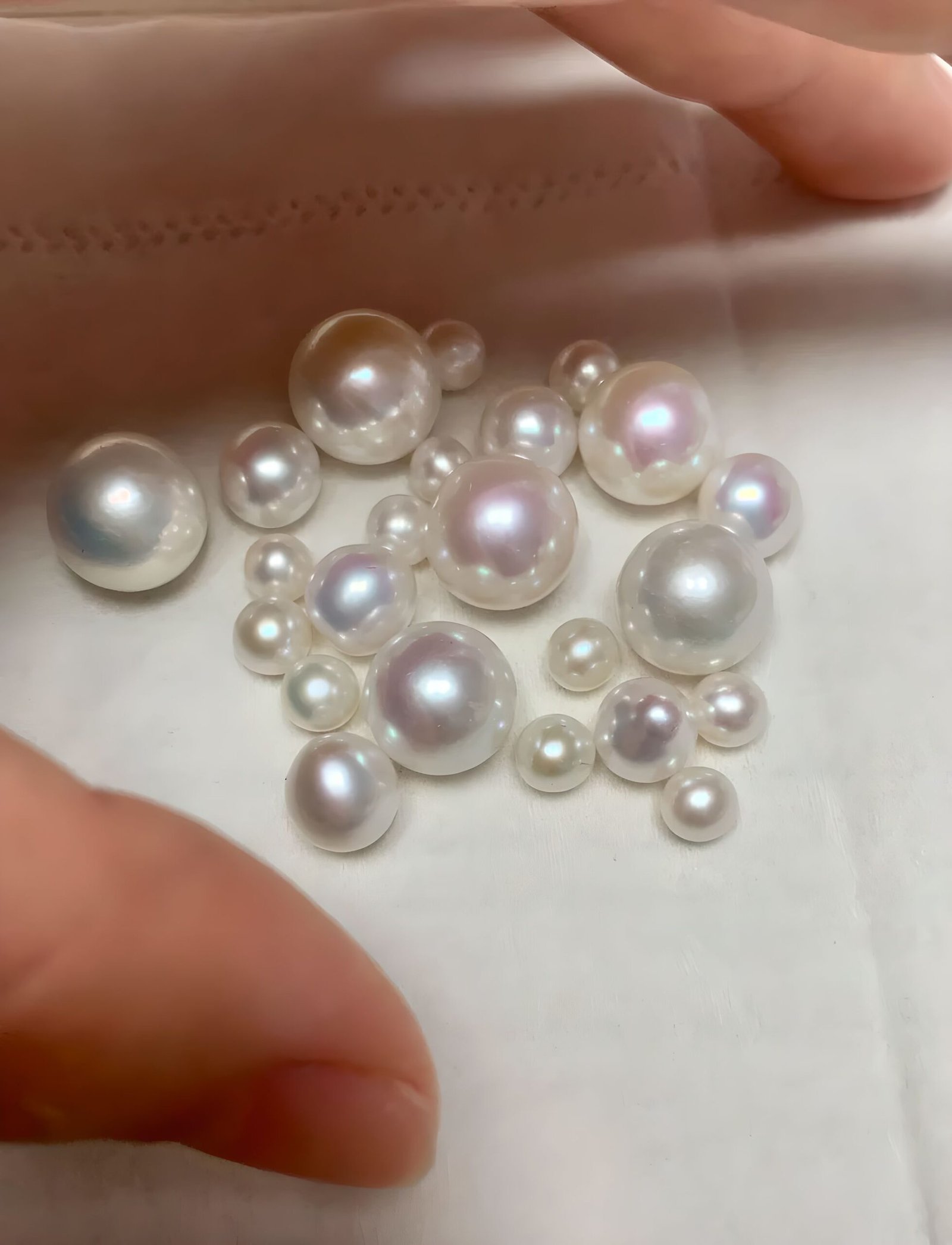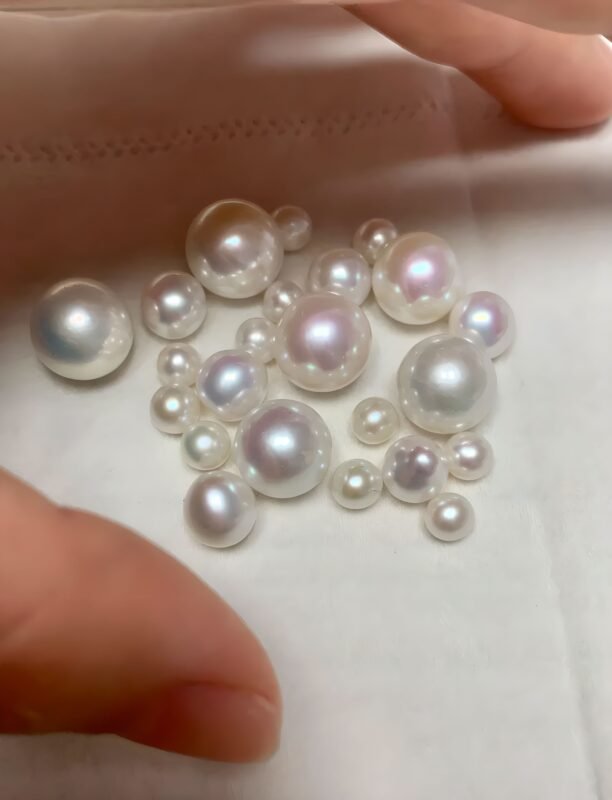Exploring the Realm of Pearls: A Guide to Assessing Pearl Quality

Enchanting Pearls
This spectacular necklace, crafted from drop-shaped metallic Edison Freshwater pearls, has dimensions ranging from 14 to 15mm. The vibrant color and metallic shine combined with its grand size create an irresistible allure!
Your Inquiries …
We are constantly approached with questions from pearl enthusiasts globally. Here, we share our insights to help everyone understand more about pearls!

Identifying High-Quality Pearls
Our Response:
Pearl Luster
Luster stands out as the pivotal aspect of a pearl’s value, surpassing other attributes like surface condition, symmetry, size, and hue. A pearl lacking in luster is typically less valuable. Experts use luster as part of the well-known “Value Factors” to grade pearls.
Luster in pearls encompasses three main attributes:
Major pearl varieties are graded “AAA Quality” with a luster rating from “High to Very High,” as each kind interacts with light uniquely and requires a suitable assessment scale.
Pearl Surface Quality
No two pearls are completely identical, primarily due to surface quality variations. Nearly every pearl possesses small imperfections, and completely flawless pearls are rare gems.
Most pearl purchasers will notice minor surface flaws, yet dedicated pearl connoisseurs recognize that even top-tier pearls might have surface irregularities. The focus is on the visibility of these blemishes and whether they significantly hamper the pearl’s durability.
Noteworthy surface concerns, such as chips or gaps, diminish the value of even the most lustrous pearls as they increase the risk of cracking or peeling. Certain imperfections, like minor flaws near the pearl’s drill hole, might not even catch a pearl enthusiast’s eye.
Nacre Thickness
Nacre forms the foundation of pearls. Given that nacre influences luster, nacre quality substantially impacts a pearl’s valuation. In essence, thicker nacre equates to a more valuable pearl not only in appearance but also in endurance.
Nacre quality typically falls into three categories:
Essentially, high-caliber pearls must meet the “acceptable” standard.
Pearl Color
Pearl Shape
When envisioning a pearl necklace, you’re likely picturing the archetypal white Akoya pearl necklace, perfectly round in form. However, there is flexibility beyond this classic image.
Shape significantly affects a pearl’s grading and value. The pinnacle in pearl shapes is the perfectly Round form, which is rare and highly coveted for its elegance.
Outside the Round category, the appeal lies in shapes that are smooth and symmetrical. Thus, Drop Shaped pearls are noted for their monetary value. Despite being considered less valuable, Baroque pearls often find favor due to their distinct appearance.
Selecting a pearl shape often depends on intuition, but some guidance can streamline your search.
For a traditional “Classic” look, opt for True Round pearls. Major candidates include Akoya pearls, superior Freshwater pearls, and Round Tahitian or South Sea pearl necklaces.
For a luxurious Round pearl necklace without the hefty price tag, investigate Near-Round and Button-Shape strands.
Drop-Shaped pearl necklaces offer uniqueness while maintaining a romantic appearance. Drops are an excellent choice for indulging in high-end Tahitian or South Sea pearls without the premium price True Rounds command.
Baroque pearls suit those seeking uniqueness after acquiring basics. Whether preferring classic Baroque shapes, heavily Circled pearls, or the Free Form Baroque, the options are vast and endlessly fascinating.
Pearl Size
Pearls are generally measured in millimeters. Akoya pearls typically have half-millimeter measurements, often evident in necklaces, bracelets, earrings, and pendants ranging from 6.0 to 6.5 mm or larger.
Tahitian, South Sea, and Freshwater pearls are measured in full millimeter increments, with jewelry featuring sizes like 10.0 – 11.0 mm.
Though a half-millimeter increase seems small, it signifies a notable size enhancement, often translating to a 15-20% size increase.
Akoya pearls are among the tiniest cultured pearls, available from 1.0 mm up to 9.5 mm, and occasionally 10.0 mm. Common sizes range from 6.0 – 6.5 mm up to 9.0 – 9.5 mm.
To gauge pearl sizes, consider that a #2 pencil’s diameter of 4.25 mm can compare to a 6.0 – 6.5 mm pearl. Likewise, with marbles around 10.0 mm, a 9.5 mm Akoya pearl earring slightly undercuts that size.
In popularity, Akoya pearl sizes for necklaces, bracelets, and earrings generally span 6.5 – 7.0 mm, 7.0 – 7.5 mm up to 8.0 – 8.5 mm.
Visual Guides
Featured Pearls
White South Sea Pearl and Diamond Ruby Ring
Keywords
- Pearl Luster
- Pearl Surface Quality
- Pearl Shape
Cleaned Alt Text
- “Pearls of Joy: Kokichi Mikimoto Quote on Pearls Adorning Necklaces of Women Worldwide”
- “Metallic Drop-Shape Freshwater Pearl Necklace Highlight”
- “Close-Up of High-Quality Hanadama Akoya Pearls”
- “Examples of Pearl Luster Evaluation”
- “Examining Pearl Surface Quality”
- “Hanadama Pearl Luster with Certification”
- “Rainbow of Colorful Freshwater Pearls”
- “Freshwater Pearls in an Array of Colors”
- “Illustrated Guide to Pearl Sizes”
- “Product Showcase: White South Sea Pearl & Jewel-Encrusted Ring”
